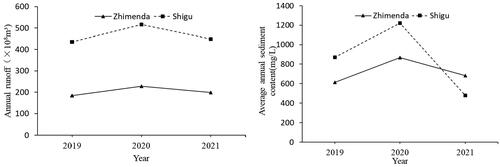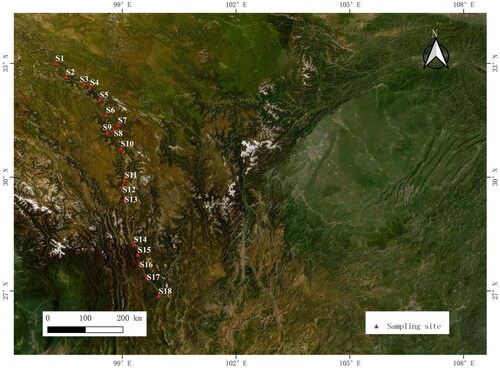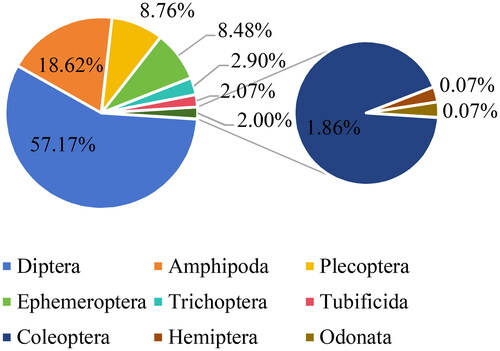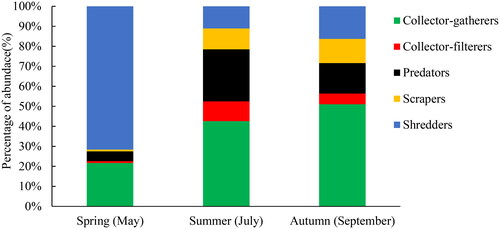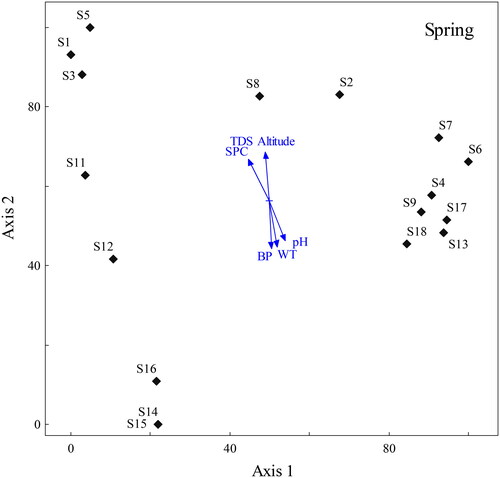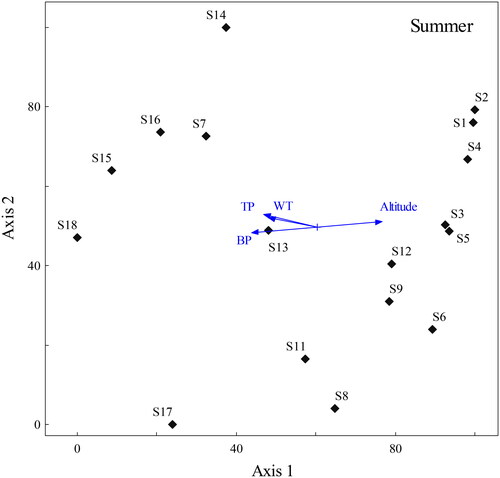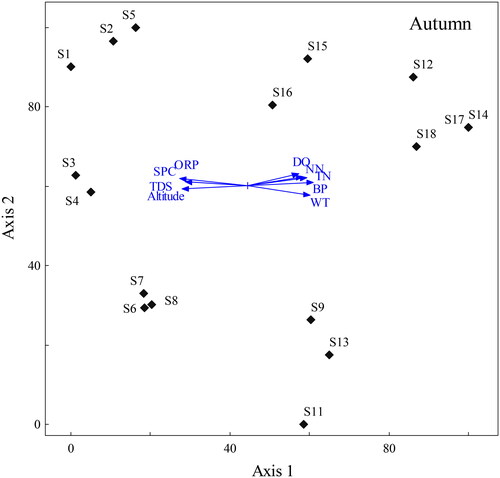Abstract
To date, the knowledge of benthic macroinvertebrates in the upper reaches of the Jinsha River remains quite limited compared to other rivers in China due to the difficulty of sampling and special geographical environment. In this study, benthic macroinvertebrates in the upper reaches of the Jinsha River were investigated to address the knowledge gap. The results showed that dipterans dominated the communities, followed by amphipods and EPT taxa. The density, biomass and biodiversity were at a low level. As a high sediment-loaded river, unlike the Yellow River and the Wei River, oligochaetes are not commonly found in the upper reaches of the Jinsha River, and no mollusks were collected. The results of db-RDA showed that some natural factors influenced the spatial distribution of benthic macroinvertebrates in both dry and wet seasons, but during the flood season (summer and autumn), nitrogen and phosphorus became important factors due to severe soil erosion and high sediment loads in the water. The sections between above Batang and below Batang have obviously different substrates, resulting in the significantly different species composition and functional feeding groups. Moreover, higher habitat diversity can lead to higher benthic macroinvertebrate diversity after comparing the substrate types of the two sections. We consider that the unstable habitat conditions in the upper reaches of the Jinsha River are not conducive to completing the entire life cycle of benthic macroinvertebrates within a localized small habitat, and the communities are likely influenced more by seasonal contributions from populations in tributaries. Considering the impact of the existing cascade hydropower stations in the middle and lower reaches, and the realistic and potential impacts expected from the planned cascade hydropower stations in the upper reaches, it is imperative to prioritize the conservation of the tributaries along both banks of the upper Jinsha River. This enhanced conservation effort aims to preserve the diversity and integrity of benthic macroinvertebrates, which is of great significance in providing reliable food sources for the rare cold-water fish species and ensuring the safety of the aquatic ecosystem in the region.
Introduction
The development of both ancient and modern civilizations has been influenced by large rivers, which provide water resources and rich floodplain soils, which are crucial for sustaining populations and establishing agricultural economies (Zhao et al. Citation2011). The Jinsha River, as an upstream segment of the Yangtze River, is no exception. It has a large and concentrated drop in the river channel, abundant water resources and a high sediment content during the flood season, making it a major source of sediment for the Three Gorges Reservoir. It is also an important source of floodplain soil in the lower Yangtze River (Chi et al. Citation2022). A series of interconnected cascading hydropower stations have been built in the middle-lower reaches of the Jinsha River (Wei et al. Citation2020; H. Zhang, Zhu, et al. Citation2021). Although there are four planned hydropower stations under construction in the upper reaches, namely Yebatan, Lawa, Suwalong and Batang, the upper reaches have largely maintained their natural condition (Chi et al. Citation2022; Sun et al. Citation2022; Xiong et al. Citation2022). High altitude, sparse population, relatively low industrial and agricultural pollution, as well as a harsh natural environment and prominent geological hazards, characterize the upper reaches of the Jinsha River, making the regional ecological environment fragile. Subarctic and temperate climates characterize the upper reaches of the Jinsha River, where the valley mostly exhibits a V-shaped or U-shaped profile. Fish resources, faunal composition, and geographic distribution in this catchment are influenced by the unique natural conditions of the Jinsha River (Wu and Wu Citation1990).
In China, the Jinsha River basin is an area of rich biodiversity. It serves as an important ecological security barrier in Southwest China and is a habitat for many rare and endemic fish species (Chi et al. Citation2022). However, due to the high attention paid to fish, the knowledge about ecological communities in this area is primarily limited to fish, with very limited understanding of other biological groups. The complex terrain of the region and the difficulty in sampling are also related to this. The current available data on benthic macroinvertebrates in the Jinsha River basin is very scarce (H. Zhang, Zhu, et al. Citation2021; Chi et al. Citation2022). The status of macroinvertebrates can offer feedbacks to the changes in ecological condition, as an important component of aquatic ecosystems (Su et al. Citation2019). Spatial variation in river hydrologic characteristics is determined by climate variations and moderated by catchment geology, topography, and vegetation. These factors interact at different spatial and temporal scales, impacting the physical habitat for aquatic biota, as well as influencing the availability of refuges, the distribution of food resources, movement and migration opportunities and conditions favorable for reproduction and recruitment (Kennard et al. Citation2010). Thus, rivers with different climates and catchment features have a specific composition of benthic macroinvertebrates (Su et al. Citation2019).
Until now, the knowledge of benthic macroinvertebrates in the upper reaches of the Jinsha River has been limited compared to other rivers in China. In order to address this knowledge gap, macroinvertebrates were collected in the upper section of the Jinsha River. Due to the occurrence of freezing phenomena during the cold winter in the upstream of Batang (above Batang), which exhibits a significantly different climate compared to the downstream (below Batang), the upper reaches of the Jinsha River were divided into two sections to conduct a comparative analysis on their community structure characteristics. Furthermore, as sampling is not feasible during winter, it was only conducted during the spring, summer and autumn seasons. The spring season represents the low-water period (dry season), whereas the summer and autumn seasons correspond to the high-water period (wet season). Given the short duration of the normal water period, it was not taken into account in this study. The objective of this study was to describe the community characteristics of macroinvertebrates and provide a basis for a comprehensive evaluation of biodiversity.
Materials and methods
Study area
The Jinsha River is the main source of discharge and sediment in the Upper Yangtze River. It provides approximately 38% of discharge (∼140 billion m3) and 57% of sediment load (∼230 million t) to the Upper Yangtze River annually (Li et al. Citation2018). The river is famous for its large yellow sand in wet seasons, or the rich sand gold of water in legend. It flows through Qinghai, Xizang, Sichuan, and Yunnan, with a total length of about 2300 km, a catchment area of 362,000 km3 (H. Zhang, Zhu, et al. Citation2021). The whole Jinsha River basin has complex and diverse landforms, great climate change, rich resources and an extremely backward economy. Furthermore, it is a typical ecologically fragile area in China (Pu and Bai Citation2010).
In the Jinsha River basin, the wet season is from June to October, and the dry season is from November to May of the next year. The upper reaches of the Jinsha River, located at the junction of Sichuan, Yunnan, Xizang and Qinghai, span 984 km and have a drop of 1720 m. Above Batang, sediment primarily results from alpine cold and frozen weathering, as well as collapses and landslides of valley slopes. Below Batang, sediment is mainly derived from the steep slopes of high and middle mountains. In history, occurrences of slumping, landslides, and blockages have been frequent in this region (Wei et al. Citation2020). There are no big tributaries on both banks of the Jinsha River, and the upper reaches of the river are in the less rainy zone. The hydrological station Shigu has an average annual flow of 1340 m3/s, an average annual runoff of 4.2 × 1010 m3, and an average annual sediment discharge of 2.385 × 1010 kg. The maximum water level is 1825.51 m and the minimum water level is 1817.64 m. The water during wet seasons exhibits a muddy yellow hue, with a low level of transparency and a high level of sediment content, whereas during dry seasons, it exhibits a relatively high level of transparency. According to the statistical data presented in the Yangtze River Sediment Bulletin for the years 2019–2021, the annual average sediment concentration in Zhimenda is 725.6 mg/L, whereas in Shigu, it is 701.6 mg/L ().
Sample collection
The sampling area was situated in the region stretching from Zhimenda in Qinhai Province to Shigu in Yunnan Province. In this section, a total of 18 sampling sites were established to collect environmental parameters and macroinvertebrate samples (). In the formal sampling, the site S10 was located in the construction area of Yebatan hydropower station. The water current was very strong, and there was no suitable site nearby to replace it. Therefore, this sampling site was abandoned. During 2019–2021, 51 benthic macroinvertebrate samples were collected, including three seasons (spring, May of 2021; summer, July of 2020; autumn, September of 2019). At each site, altitude, river width (RW), velocity, barometric pressure (BP), water temperature (WT), dissolved oxygen (DO), specific conductivity (SPC), total dissolved solids (TDS), pH, oxidation-reduction potential (ORP), ammonia nitrogen (AN), nitrate nitrogen (NN), total nitrogen (TN), phosphate, total phosphorus (TP) and chemical oxygen demand (CODMn) were recorded simultaneously with macroinvertebrate samples. The parameters, including BP, WT, DO, SPC, TDS, pH and ORP, were measured by the YSI water quality analyzer, while the nutritional variables, including AN, NN, TN, phosphate, TP and CODMn, were measured in the laboratory in accordance with the national standards of China (Editorial Committee of the National Environmental Protection Administration Citation2002). The benthic macroinvertebrate samples were collected using a rectangular kicknet with a long handle (25 cm × 25 cm, 200 cm) from sites with shallow water depths nearby the riverbank. Benthic macroinvertebrate organisms were live-picked and preserved in 10% formalin solution. The sorted samples were weighed (wet weight, accuracy 0.0001 g) with an electronic balance for biomass calculations. The sampling area was measured by taking the frame width of the kicknet, multiplied by the movement distance of the kicknet frame (Chi et al. Citation2022).
Data analysis
To measure the biodiversity of benthic macroinvertebrates, the Shannon–Wiener diversity index, Simpson diversity index, Pielou’s evenness index, and Hill number (D0, D1 and D2) were calculated (Chao et al. Citation2014). Multiresponse permutation procedures (MRPPs) were used to test the significance of differences in benthic macroinvertebrate species composition and functional feeding groups between pair-groups. A distance-based redundancy analysis (db-RDA) was conducted to explore the relationships between benthic macroinvertebrates and environmental parameters. The diversity indices were calculated by Package ‘vegan; of R language version 4.3.1 (R Core Team Citation2023). PC-ORD version 7.0 was used to perform mantel analysis, MRPP and db-RDA. Before MRPP and dB-RDA, the benthic macroinvertebrate abundance data were log (x + 1) transformed. In the db-RDA analysis, the cutoff r2 value was set to 0.40 for selecting the significant environmental factors to benthic macroinvertebrates (Mccune and Mefford Citation1999; Peck Citation2010).
Results
Environmental parameters
The upper reaches of the Jinsha River had a higher altitude, with an average altitude of over 3000 m above Batang. Below Batang, the average altitude was over 2000 m. Air pressure decreased with an increase in altitude. The RW above Batang was noticeably smaller than below, with the width being higher during the wet season (summer and autumn) compared to the dry season (spring). The WT in all three seasons was significantly lower above Batang compared to below Batang. The concentration of DO was lower in the upper regions as compared to the lower regions. SPC and TDS displayed an obvious gradient, with higher values in the upper than in the lower. The ORP was significantly lower above Batang during the spring, but the opposite occured during the autumn season. The gradient was not clear during the summer. During the summer, the AN was much higher above Batang than below Batang, with no obvious differences between the spring and autumn seasons. The NN content was higher in spring compared to summer and autumn, whereas the TN content exhibited minimal variation across the three seasons. The phosphate content remained relatively low throughout all three seasons; however, the TP content was significantly higher during the summer and autumn as compared to the spring. The CODMn was within the Class III limit for surface water of China ().
Table 1. Environmental factors in the upper reaches of the Jinsha River.
Species composition
During the study, a total of 1450 individuals were collected and 84 taxa were identified, belonging to 2 phyla, 3 classes, 9 orders and 73 genera. The dominant taxa were Gammarus sp., Togoperla sp., Heptagenia sp. and Polypedilum laetum. In spring (May), the predominant taxa were Polypedilum laetum, Gammarus sp. and Polypedilum albicorne. In summer, the predominant taxa were Gammarus sp., Togoperla sp., Heptagenia sp., Hexatoma sp., Hydropsyche sp. and Optioservus sp. Furthermore, the predominant taxa in autumn were Gammarus sp., Togoperla sp., Baetis sp., Heptagenia sp. and Polypedilum paraviceps. Among the broad taxonomic groups, dipterans represented the most diverse group, with 55 taxa and chironomids dominated the group, with 78.18%. The most abundant groups collected were dipterans, followed by amphipods and the abundance proportion of EPT taxa was relatively low. The other taxonomic groups were very few in abundance (). Collector-gatherers dominated the benthic macroinvertebrate communities in the wet seasons (summer and autumn), whereas shredders dominated the benthic macroinvertebrate communities in the dry season (spring). In wet seasons like summer and autumn, the composition ratio of functional feeding groups was relatively close to each other ().
Density and biomass
In total, the mean macroinvertebrate density and biomass were at a low level, with the highest in mean density in spring, the second in summer and the lowest in winter. The mean biomass in spring and summer was much higher than in autumn. In spring and summer, the mean macroinvertebrate density above Batang was much higher than that below Batang, while in autumn, the difference was small. In spring and autumn, the biomass in the areas above Batang was much higher than that in the areas below Batang, but there was not a much difference in summer ().
Table 2. The density and biomass of macroinvertebrates in the upper reaches of Jinsha River.
Biodiversity
In terms of river segments, the Shannon–Wiener index, Simpson diversity index, D0, D1 and D2 indices were all higher above Batang than below Batang in different seasons, while the Pielou index was higher below Batang than above Batang (). In different seasons, the Shannon–Wiener index, Simpson diversity index, and Pielou evenness index were higher during the wet season (summer and autumn) compared to the dry season (spring). The D0 index was higher in spring and summer compared to autumn, while the D1 and D2 indices were slightly higher in summer compared to spring and autumn. The differences between the D2 and D1 indices in different seasons were small, suggesting a lower intensity of species competition within the communities ().
Figure 5. Spati-temporal distribution of macroinvertebrate diversity in the upper reaches of Jinsha River.
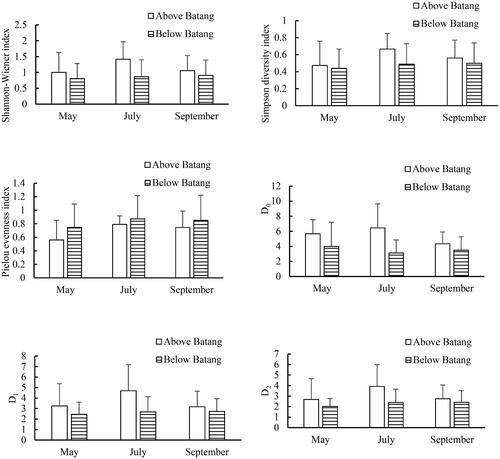
Table 3. Macroinvertebrate diversity of the upper reaches of Jinsha River in different seasons.
Multivariate analysis
The differences in benthic macroinvertebrate community structure between different seasons in the upper reaches of the Jinsha River were statistically significant (p < 0.05), whereas the differences in feeding functional groups were significant in all seasons except for summer and autumn (). In terms of community structure and feeding functional groups, the differences between above Batang and below Batang were insignificant in the spring, but reached a significant level in the summer and autumn ().
Table 4. Seasonal differences in benthic macroinvertebrate community structure and feeding functional groups based on MRPP test results.
Table 5. River segment-scale differences in benthic macroinvertebrate community and feeding functional groups among different seasons based on MRPP test results.
The results of db-RDA analyses showed that several factors significantly influenced the benthic macroinvertebrate community in different seasons. In the spring season, environmental factors such as TDS, SPC, BP, WT, pH and altitude were found to be important (). For the summer season, the important factors were TP, WT, altitude and BP (). In the autumn season, the important factors were ORP, SPC, TDS, altitude, DO, TN, NN, BP and WT ().
Discussion
In China, there exist two major rivers that resemble the Jinsha River in terms of their high sediment load, namely the Yellow River and the Wei River. The Jinsha River is distinguished by more water and more sediment content, whereas the Yellow River and the Wei River have less water and more sediment content (Fu et al. Citation2010; Yin et al. Citation2013; Yang et al. Citation2020). Due to its relatively harsh natural environment, there have been fewer aquatic surveys conducted in the Jinsha River, resulting in limited data on benthic macroinvertebrates compared to the Yellow River and the Wei River. The degradation of the ecosystems in the Yellow River and the Wei River is mainly attributed to excessive human activities, particularly agricultural practices (Zhao et al. Citation2011; Yin et al. Citation2013). Conversely, the degree of human disturbance in the upper Jinsha River is relatively low, and the fragile ecosystem is primarily due to the influence of natural factors. This study found that benthic macroinvertebrates in the upper reaches of the Jinsha River consisted mainly of aquatic insects, without mollusks. According to investigations from the Yellow River, the dominant taxa include oligochaetes and aquatic insects, with frequent occurrences of mollusks such as Radix lagotis, Corbicula fluminea and Limnoperna lacustris (Zhao et al. Citation2011). As for the Wei River, the primary species composition is comprised aquatic insects, oligochaetes and mollusks (Yin et al. Citation2013). Unlike the Yellow River and the Wei River, oligochaetes are rarely found in the upper reaches of the Jinsha River. Although all three rivers are characterized by high sediment loads, the Yellow River and the Wei River have relatively stable sediment deposition environments. However, the upper reaches of the Jinsha River, with its significant drop and turbulent flow, do not provide conducive conditions for sufficient sediment deposition. Hence, it is not suitable for the survival of oligochaetes. Mollusks possess a longer lifespan in comparison to aquatic insects and necessitate relatively stable habitat conditions for their survival and reproduction (Huryn and Wallace Citation2000; Chiu and Kuo Citation2012; Lee et al. Citation2022). The harsh natural environment in the upper reaches of the Jinsha River restricts their existence, which may account for the absence of mollusk collection in this research.
In terms of environmental factors in the upper reaches of the Jinsha River, in addition to nutrient indicators, other factors, such as altitude, BP, RW, WT, DO, SPC and TDS exhibited evident gradient variations. For instance, the altitude gradually decreased from upstream to downstream, the BP gradually increased, the RW, WT and DO gradually increased, while SPC and TDS gradually decreased. The spatial distribution of benthic macroinvertebrates in different seasons was significantly impacted by these gradient variations in natural factors. Based on the results of the db-RDA, the main factors influencing the community structure of benthic macroinvertebrates in the spring were identified as the total dissolved solids, SPC, BP, WT and altitude. The main factors influencing community structure were WT, altitude and BP in the summer, while SPC, total dissolved solids, altitude, DO, BP and WT were the main factors influencing community structure in the autumn. The investigation of the Wei River has demonstrated that the alterations in the natural environment are evident due to the gradients. The spatial distribution of benthic macroinvertebrates is influenced by factors, such as altitude, RW, water depth, flow velocity, discharge, TN, SPC, CODMn, water hardness and alkali (Yin et al. Citation2013). Similar to the Wei River, gradient changes in natural environmental factors in the upper reaches of the Jinsha River lead to variations in the spatial distribution of benthic macroinvertebrates. Conductivity has the potential to exert a significant influence on benthic macroinvertebrate communities in rivers that are high sediment-loaded, such as the Yellow River (Xie et al. Citation2018) and the Wei River (Yin et al. Citation2013). The upper reaches of the Jinsha River are no exception, as indicated by the findings of this study, where conductivity was identified as an important factor influencing benthic macroinvertebrate communities in both spring and autumn seasons.
Compared to the Yellow River Basin, the upper reaches of the Jinsha River have a smaller population due to the harsh natural environment. This results in less human disturbance. Although the region has a high biodiversity, its ecosystem is extremely fragile and recent activities, such as hydropower development and urbanization have posed a certain degree of threat to its biodiversity. Similar to the Yellow River Basin, the upper reaches of the Jinsha River have a high sediment content during the flood season, which serves as the main source of sediment for the Yangtze River Estuary and continuously replenishes the soil in the surrounding plains of the middle and low reaches of the Yangtze River. Studies have demonstrated that natural factors, such as water flow, floods and velocity can influence the composition of benthic macroinvertebrates by modifying river morphology, redistributing substrate materials and moving the detritus and sediments (Duan et al. Citation2009; Su et al. Citation2019). Human activities, such as river channel modifications, urbanization, agricultural activities and wastewater runoff, can affect the conditions of benthic macroinvertebrate habitats and consequently impact the benthic macroinvertebrate communities (Su et al. Citation2019). In the upper reaches of the Jinsha River, the main factors influencing the distribution of benthic macroinvertebrates were natural environmental factors. During the flood season (summer and autumn), nitrogen and phosphorus became the primary environmental factors due to severe soil erosion and the presence of high sediment loads with certain gradient changes in the water. In austral ecosystems, water chemistry variables possess a greater predictive ability for modifications in the composition of benthic macroinvertebrate communities, which is closely associated with the lower water availability in the region (Erasmus et al. Citation2021). The Jinsha River is known for its abundance of water and sediment, and it does not face significant water pollution issues. The distribution of benthic macroinvertebrates was significantly influenced by natural environmental factors, even during the dry season (spring). Benthic macroinvertebrate communities are primarily impacted by substrate composition and flow conditions, and are generally unaffected by latitudinal position and macroclimate (Duan et al. Citation2009). In the upper reaches of the Jinsha River, there exist significant distinctions in the riverbed substrate types between the sections above and below Batang. For instance, the upper regions above Batang comprise substantial gravels and bedrock, whereas the lower regions below Batang predominantly comprise small gravels and fine sand. The differences in riverbed substrate types lead to significant differences in species composition and feeding functional groups of benthic macroinvertebrates between the two sections. At a local level, habitat structure promotes the colonization and retention of benthic macroinvertebrates by increasing habitat diversity. Rocks and similar physical objects provide additional food and habitat by trapping particulate matter. This indirectly benefits benthic macroinvertebrates (Stewart et al. Citation2003). Many studies have confirmed that larger grain size substrates are structurally more complex than sand, and therefore capable of housing a large number and variety of individuals when compared with sandy substrates (de Castro Vasconcelos and Melo Citation2008; Buendia et al. Citation2011; Larsen et al. Citation2011; Graca et al. Citation2015). The results indicated that the diversity of benthic macroinvertebrate in the section above Batang was significantly higher than that in the section below Batang (). This was partly attributed to the higher habitat diversity in the section above Batang.
Benthic macroinvertebrates are particularly sensitive to changes in river discharges. Changes in river discharges lead to corresponding changes in species composition, abundance and community structure of benthic macroinvertebrates (Yin et al. Citation2015; Qi et al. Citation2019). It is possible that significant differences in community structure of benthic macroinvertebrates can be attributed to dynamic changes in natural environmental factors. For example, during low-flow and high-flow periods, there are significant differences in factors, such as flow velocity, WT, conductivity, TDS and ORP. Aquatic communities can exhibit high resilience to disturbance (Johnson and Vaughn Citation1995). However, excessive disturbance intensity makes it challenging to restore the original levels of biodiversity and community structure. The instabilities in the upper reaches of the Jinsha River render it challenging for benthic macroinvertebrates to complete their entire life cycle within a restricted, localized habitat. As a result, the composition of these communities is likely to be influenced more by seasonal contributions from populations in tributaries. The various tributaries situated in the upper reaches of the Jinsha River provide more favorable habitat conditions in comparison to the mainstream. These suitable habitats contribute to the population size and diversity of benthic macroinvertebrates, thereby serving as stable sources of supplementation for populations in the mainstream, which experience more adverse environmental conditions (Stewart et al. Citation2003; Chi et al. Citation2022).
In Lower Rio Negro, State of Amazonas, Brazil, the macroinvertebrate community showed adaptation to the available substrate in each season (Nessimian et al. Citation1998). Shredders were sampled mainly during the high water period, and collector-gatherers were clearly predominant during the dry period. Scrapers were limited to the rising and falling water periods (Nessimian et al. Citation1998). In this study, it was observed that shredders prevailed during the dry season, whereas collector-gatherers dominated in wet seasons, accompanied by a notable increase in the proportion of collector-filterers and scrapers. The higher proportion of collectors in the wet seasons likely stems from the abundant food resources stemming from the substantial deposition of particles on the riverbed surface. The Bermejo River is renowned for its high silt load, with suspended sediment content peaking at 40,000 mg/L during high water periods and averaging 6500 mg/L annually (Zalocar de Domitrovic et al. Citation2014; Blettler, Amsler, Ezcurra, Drago, Espinola, et al. Citation2015). The case study on the Bermejo River exemplifies that diatoms tend to dominate in turbulent and turbid water bodies, with their density, biomass, diversity, and species richness declining with rising suspended particulate matter and conductivity (Zalocar de Domitrovic et al. Citation2014). Analogous findings have been documented in the upstream regions of the Jinsha River (Hu et al. Citation2022; Sun et al. Citation2022). The substantial influx of sediment poses adverse impacts on benthic macroinvertebrate communities. For instance, the introduction of a high volume of fine particulate sediments from the Bermejo River into the Paraguay River significantly reduces the density and species richness of benthic macroinvertebrates downstream at the confluence (Blettler, Amsler, Ezcurra, Drago, Paira, et al. Citation2015). Any form of substrate instability exerts a considerable negative impact on benthic macroinvertebrates. Sandy substrates not only harm the organs of these creatures but also disrupt their stable habitats (Q. Zhang, Yang, et al. Citation2021). The upper reaches of the Jinsha River primarily comprise a blend of gravel and fine sand as substrates, with the instability of the fine sand adversely affecting the benthic macroinvertebrates residing within it.
Turbidity is an important water quality parameter, through its relation to light suppression, BOD impact, sediment-associated contaminant transport and suspended sediment effects on organisms and habitats (Lawler et al. Citation2006). An increase in turbidity impedes light penetration, thereby reducing primary productivity and algal abundance, ultimately limiting food and oxygen availability for certain benthic macroinvertebrates (Ryan Citation1991). This not only hampers their growth but also leads to a decline in their abundance and species diversity (Zalocar de Domitrovic et al. Citation2014; Yang et al. Citation2020; Tan et al. Citation2021; Q. Zhang, Yang, et al. Citation2021). Studies have shown a significant negative correlation between turbidity and both the diversity and abundance of macroinvertebrates (Yang et al. Citation2020; Tan et al. Citation2021). Benthic macroinvertebrates reside in riverbed sediments, relying heavily on algae, bacteria, leaves and other organic matter as nutritional sources. In the upper reaches of the Jinsha River, rapid water flow and heavy sediment loads persistently elevate turbidity levels. As a result, organic matter is unable to settle on the riverbed, drastically reducing algal abundance in the water column. Consequently, benthic macroinvertebrate abundance and diversity remain comparatively low ( and ). This, in turn, adversely affects the food availability for rare and endemic fish species in the Jinsha River, whose diet predominantly comprises benthic macroinvertebrates. The scarcity of benthic macroinvertebrates constrains fish population growth, leading to slow development of fishery in the region (Xiong et al. Citation2022).
In ecological studies, the unexplained variability in species community structure is often attributed to the lack of explanatory variables in the analysis, which is influenced by the scale and availability of those variables (Galeti et al. Citation2020). Despite the incomplete coverage of environmental variables measured in this study, macro-scale factors, such as altitude and BP were able to explain the variations in benthic macroinvertebrate communities along the longitudinal gradient of the upper reaches of the Jinsha River. Anthropogenic pressures can significantly impact macroinvertebrate communities by altering their habitat conditions (Su et al. Citation2019; Erasmus et al. Citation2021). During the study period, the upper reaches of the Jinsha River remained in a pristine state. However, with the construction of several hydropower stations, drastic changes in river morphology are anticipated. Based on observations in the mid-lower reaches of the Jinsha River, where hydropower stations have already been established, the species composition of benthic macroinvertebrates in the mainstream reservoir areas has undergone substantial shifts. Specifically, the diversity and abundance of Ephemeroptera, Trichoptera and Megaloptera have decreased to near-zero levels, while the abundance of Diptera, Chironomidae and Tubificidae has increased significantly (H. Zhang, Zhu, et al. Citation2021). Similar changes are expected in the upper reaches of the Jinsha River following the completion of cascade hydropower stations, posing a grave threat to the integrity of benthic macroinvertebrate communities in the future (Shi et al. Citation2019). The Jinsha River exhibits significant environmental variations and is abundant in fish resources. A comprehensive survey of fish resources conducted throughout the Jinsha River basin from 1983 to 1984 recorded a total of 161 species (including subspecies) of fish. However, the fish composition in the upper Jinsha River is relatively simple and markedly different from that of the downstream, which is dominated by rare cold-water fish belonging to Nemacheilidae, Sisoridae and Schizothoracinae, including Oerias dabryi, Triplophysa angeli, Triplophysa yaopeizhii, Euchiloglanis kishinouyei, Pareuchiloglanis sinensis, Schizothorax dolichonema, Schizothorax wangchiachii, Schizothorax kozlovi, Schizopygopsis malacanthus malacanthus and Ptychobarbus kaznakovi. Most of these rely on benthic macroinvertebrates as their primary food source (Hu Citation2012; Zhang et al. Citation2019). To mitigate the loss of habitat for benthic macroinvertebrates in the upper Jinsha River, it is imperative to enhance the conservation value and maintain the diversity of benthic macroinvertebrates in the tributaries along both banks. This holds significant importance in providing reliable food sources for rare cold-water fish species, and ensuring their survival ensuring the safety of the aquatic ecosystem in the region.
Conclusion and recommendation
The upper reaches of the Jinsha River with high sediment load and harsh natural environment, supports a benthic macroinvertebrate community dominated by aquatic insects. The absence of mollusks and limited presence of oligochaetes in this region is attributed to the dynamic flow conditions and lack of stable sediment deposition environments. The spatial distribution of benthic macroinvertebrates is significantly influenced by natural environmental factors, such as altitude, WT, DO, SPC and total dissolved solids, which exhibit evident gradient variations along the river. The results indicate that the upper section above Batang has higher habitat diversity and subsequently higher benthic macroinvertebrate diversity compared to the lower section. The fragile ecosystem of the upper Jinsha River is primarily impacted by natural factors, though recent anthropogenic activities, especially hydropower construction, pose a potential threat to its biodiversity. To mitigate habitat loss for benthic macroinvertebrates in the upper Jinsha River, enhancing conservation in tributaries is crucial. This preserves food sources for rare cold-water fish, ensuring their survival and aquatic ecosystem safety.
Authors’ contributions
Shiyun Chi analyzed the data and wrote the manuscript, Jun Hu gave some advices and finacial support, Jinxiu Zhen sampled the benthic macroinvertebrates and revised the English, Ming Li helped revise and polish the English, Mi Wei sampled the benthic macroinvertebrates, and Juxiang Hu designed the project.
Ethics approval and consent to participate
This study did not include the use of any animals, human or otherwise, so did not require ethical approval.
Availability of data and material
Not applicable.
Supplemental materials.docx
Download MS Word (1.3 MB)Acknowledgments
The authors would like to express the gratitude to Keqiang Lv for his valuable assistance during the fieldwork.
Disclosure statement
The authors declare no conflict of interest.
Additional information
Funding
References
- Blettler MCM, Amsler ML, Ezcurra DD, Drago E, Paira A, Espinola LA, Eberle E, Szupiany R. 2015. Fine sediment input and benthic fauna interactions at the confluence of two large rivers. Int J Environ Res. 10(1):65–76.
- Blettler MCM, Amsler ML, Ezcurra DD, Drago I, Espinola LA, Eberle E, Paira E, Best JL, Parsons DR, Drago EE. 2015. The impact of significant input of fine sediment on benthic fauna at tributary junctions: a case study of the Bermejo-Paraguay river confluence, Argentina. Ecohydrology. 8(2):340–352. doi: 10.1002/eco.1511.
- Buendia C, Gibbins CN, Vericat D, Lopez-Tarazon JA, Batalla RJ. 2011. Influence of naturally high fine sediment loads on aquatic insect larvae in a montane river. Scott Geogr J. 127(4):315–334. doi: 10.1080/14702541.2012.670006.
- de Castro Vasconcelos M, Melo AS. 2008. An experimental test of the effects of inorganic sediment addition on benthic macroinvertebrates of a subtropical stream. Hydrobiologia. 610(1):321–329. doi: 10.1007/s10750-008-9447-4.
- Chao A, Gotelli NJ, Hsieh TC, Sander EL, Ma KH, Colwell RK, Ellison AM. 2014. Rarefaction and extrapolation with Hill numbers: a framework for sampling and estimation in species diversity studies. Ecol Monogr. 84(1):45–67. doi: 10.1890/13-0133.1.
- Chi S, Wang R, Wei M, Xu J, Dai F, Lv K, Li S, Hu J. 2022. Community structure and diversity of macroinvertebrates in the upper and middle reaches of Jinsha River based on the monitoring data from 2010-2019 (In Chinese). Acta Ecol Sin. 42(21):8723–8738.
- Chiu M, Kuo M. 2012. Application of r/K selection to macroinvertebrate responses to extreme floods. Ecol Entomol. 37(2):145–154. doi: 10.1111/j.1365-2311.2012.01346.x.
- Duan X, Wang ZY, Xu M, Zhang K. 2009. Effect of streambed sediment on benthic ecology. Int J Sediment Res. 24(3):325–338. doi: 10.1016/S1001-6279(10)60007-8.
- Editorial Committee of the National Environmental Protection Administration. 2002. Water and waste water monitoring and analysis method. 4th ed. Beijing, China: China Environmental Science Press.
- Erasmus JH, Lorenz AW, Zimmermann S, Wepener V, Sures B, Smit NJ, Malherbe W. 2021. A diversity and functional approach to evaluate the macroinvertebrate responses to multiple stressors in a small subtropical austral river. Ecol Indic. 131:108206. doi: 10.1016/j.ecolind.2021.108206.
- Fu X, Ye L, Xu Y, Cai Q. 2010. Survey of water quality and benthos in the Yellow River Basin (In Chinese). Ecol Sci. 29(1):1–7.
- Galeti G, Capitanio BM, Baldissera R. 2020. Variation of benthic macroinvertebrate communities in streams of three landscapes of South Brazilian grasslands. Rev Biol Trop. 68(1):108–121.
- Graca MAS, Ferreira WR, Firmiano K, Franca J, Callisto M. 2015. Macroinvertebrate identity, not diversity, differed across patches differing in substrate particle size and leaf litter packs in low order, tropical Atlantic forest streams. Limnetica. 34(1):29–40.
- Hu J, Song Z, Zhou J, Tan L, Tang T. 2022. Comparative study on planktonic and periphytic algal community patterns and their relationships with environmental variables in the upper reaches of the Jinsha river (In Chinese). Acta Ecol Sin. 42(2):590–599.
- Hu R. 2012. [Status and conservation of fish resources in the upper reaches of Jinsha river] [Master’s thesis]. Beijing, China: University of Chinese Academy of Sciences.
- Huryn AD, Wallace JB. 2000. Life history and production of stream insects. Annu Rev Entomol. 45(1):83–110. doi: 10.1146/annurev.ento.45.1.83.
- Johnson SL, Vaughn CC. 1995. A hierarchical study of macroinvertebrate recolonization of disturbed patches along a longitudinal gradient in a prairie river. Freshw Biol. 34(3):531–540. doi: 10.1111/j.1365-2427.1995.tb00911.x.
- Kennard MJ, Pusey BJ, Olden JD, Mackay SJ, Stein JL, Marsh N. 2010. Classification of natural flow regimes in Australia to support environmental flow management: classification of natural flow regimes in Australia. Freshw Biol. 55(1):171–193. doi: 10.1111/j.1365-2427.2009.02307.x.
- Larsen S, Pace G, Ormerod SJ. 2011. Experimental effects of sediment deposition on the structure and function of macroinvertebrate assemblages in temperate streams. River Res Apps. 27(2):257–267. doi: 10.1002/rra.1361.
- Lawler DM, Petts GE, Foster IDL, Harper S. 2006. Turbidity dynamics during spring storm events in an urban headwater river system: the Upper Tame, West Midlands, UK. Sci Total Environ. 360(1–3):109–126. doi: 10.1016/j.scitotenv.2005.08.032.
- Lee DY, Lee DS, Park YS. 2022. Taxonomic and functional diversity of benthic macroinvertebrate assemblages in reservoirs of South Korea. Int J Environ Res Public Health. 20(1):673. doi: 10.3390/ijerph20010673.
- Li D, Lu XX, Yang X, Chen L, Lin L. 2018. Sediment load responses to climate variation and cascade reservoirs in the Yangtze River: a case study of the Jinsha River. Geomorphology. 322:41–52. doi: 10.1016/j.geomorph.2018.08.038.
- Mccune B, Mefford MJ. 1999. PC-ORD. Multivariate analysis of ecological data. Version 5. Gleneden Beach (OR): MJM Software Design.
- Nessimian JL, Dorvillé L, Sanseverino AM, Baptista DF. 1998. Relation between flood pulse and functional composition of the macroinvertebrate benthic fauna in the lower Rio Negro, Amazonas, Brazil. Amazoniana. 15(1):35–50.
- Peck JE. 2010. Multivariate analysis for community ecologists step-by-step using PC-ORD. Gleneden Beach (OR): MJM Software Design.
- Pu R, Bai H. 2010. The economic development choices of the mountainous limited development zone in the middle and upper reaches of Jinsha river (in Chinese). J Hebei Univ Sci Technol Soc Sci. 10(3):16–21.
- Qi M, Li N, Sun Y, Yang C, Bai L. 2019. Community structure analysis of macrobenthos in the upper reaches of Huangshui river in Qinghai Province (in Chinese). J Qinghai Univ. 37(1):1–8.
- R Core Team. 2023. R: a language and environment for statistical computing. Vienna, Austria: R Foundation for Statistical Computing.
- Ryan PA. 1991. Environmental effects of sediment on New Zealand streams: a review. N Z J Mar Freshw Res. 25(2):207–221. doi: 10.1080/00288330.1991.9516472.
- Shi X, Liu J, You X, Bao K, Meng B. 2019. Shared effects of hydromorphological and physico-chemical factors on benthic macroinvertebrate integrity for substrate types. Ecol Indic. 105:406–414. doi: 10.1016/j.ecolind.2018.02.028.
- Stewart TW, Shumaker TL, Radzio TA. 2003. Linear and nonlinear effects of habitat structure on composition and abundance in the macroinvertebrate community of a large river. Am Midl Nat. 149(2):293–305. doi: 10.1674/0003-0031(2003)149[0293:LANEOH]2.0.CO;2.
- Su P, Wang X, Lin Q, Peng J, Song J, Fu J, Wang S, Cheng D, Bai H, Li Q. 2019. Variability in macroinvertebrate community structure and its response to ecological factors of the Weihe River Basin, China. Ecol Eng. 140:105595. doi: 10.1016/j.ecoleng.2019.105595.
- Sun T, Chen J, Zhang Y, Wei C, Zhang C. 2022. Analysis of phytoplankton community characteristics and their relationship with environmental factors from Yebatan to Suwalong in the upper reaches of Jinsha River. (In Chinese). Freshw Fish. 52(2):57–65.
- Tan Y, Zheng X, Chen C, Liu Y, Wang L, Guan Z, Yang H, Han B. 2021. Temporal and spatial distributions of macroinvertebrates and their influencing environmental factors (in Chinese). Acta Ecol Sin. 41(2):747–760.
- Wei Z, He Y, Gong J, Zhu T, Meng Z, Cai Y, Yang D. 2020. Temporal and spatial variation of phytoplankton community structure in the main stream of the Jinsha river (in Chinese). Resour Environ Yangtze Basin. 29(6):1356–1365.
- Wu J, Wu M. 1990. Fish fauna of the Jinsha river (In Chinese). Sichuan J Zool. 9(3):23–26.
- Xie Y, Jiang X, Wang T, Xu X, Ni J. 2018. Comparative study on macroinvertebrate communities in confluence areas from typical tributaries to mainstream of the yellow river (in Chinese). Acta Sci Nat Univ Pekin. 54(5):1067–1076.
- Xiong M, Shao K, Dong W, Chen H, Zeng C, Que Y, Chen F, Zhu B. 2022. Study on fish community structure of the main river below batang hydropower station and the tributary Bachu river in the upper reaches of Jinsha river (in Chinese). Resour Environ Yangtze Basin. 31(11):2481–2488.
- Yang H, Pan B, Zhu P, Jiang W, Jiang X, Hou Y. 2020. Structure of macroinvertebrate communities and bioassessment of water quality in the Weihe Rivet mainsheam and its typical trioutaries from the northern Qinling Mountains (in Chinese). J Lake Sci. 32(6):1793–1805. doi: 10.18307/2020.0619.
- Yin X, Li Q, Zhu M, Song J, Wu W, Xu Z. 2015. Community structure and biological integrity of macroinvertehrates in the wet and dry seasons of Wei river basin, China (in Chinese). Acta Ecol Sin. 35(14):4784–4796.
- Yin X, Xu Z, Gao X, Bai H, Wu W, Song J. 2013. Macrobenthos community structure and its relationships with environmental factors in Weihe river basin, Northwest China (in Chinese). Chin J Appl Ecol. 24(1):218–226.
- Zalocar de Domitrovic Y, Devercelli M, Forastier ME. 2014. Phytoplankton of the Paraguay and Bermejo rivers. Adv_Limnol. 65:67–80. doi: 10.1127/1612-166X/2014/0065-0034.
- Zhang C, Yang J, Zhao Y, Pan X. 2019. Fishes in the Jinsha Jiang river basin, the upper reaches of the Yangtze river China. Beijing, China: Science Press.
- Zhang H, Zhu C, Mo K, Chen Q, Tang L, Zhang J, Li T, Wang J. 2021. Dam cascade alters taxonomic composition of benthic macroinvertebrate community in upper Yangtze River. River Research & Apps. 37(8):1070–1079. doi: 10.1002/rra.3787.
- Zhang Q, Yang T, Wan X, Wang Y, Wang W. 2021. Community characteristics of benthic macroinvertebrates and identification of environmental driving factors in rivers in semi-arid areas – A case study of Wei River Basin, China. Ecol Indic. 121:107153. doi: 10.1016/j.ecolind.2020.107153.
- Zhao W, Wang H, Wang H, Close PG. 2011. Macroinvertebrates in the bed sediment of the Yellow river. Int J Sediment Res. 26(3):255–268. doi: 10.1016/S1001-6279(11)60092-9.

